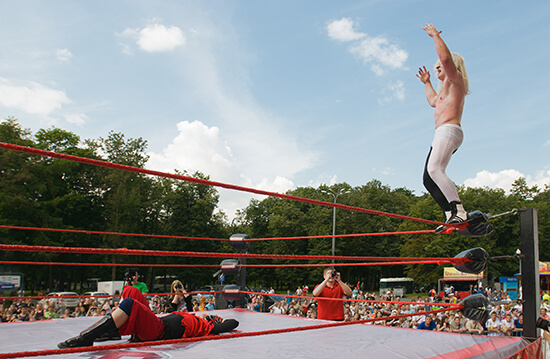
When you think of brands doing forward-thinking, progressive marketing and PR work, would your first thought be one where people hit one another with steel chairs?
Probably not.
However, when looking at the most impressively marketed entertainment brands in the world today, it’s hard to argue against the dominance of the WWE.
Kayfabe and Shoot: Marketing Tag Team Champions
If anything is true about the business world, in general, it’s that if you don’t learn how to adapt, you’re going to have a very difficult time sticking around for the long haul.
It’s hard to imagine a brand that has undergone more uncomfortable change than the WWE, nor one that has benefitted from it more.
In professional wrestling, the term kayfabe describes the fiction that happens in the ring, versus things that are real, or shoot.
At one time, it was considered a sin in the wrestling world to break kayfabe.
If a wrestler was seen hanging out in public with someone they were supposed to be enemies with, they could lose their job.
These days, wrestlers are much more able to break character in public.
By acknowledging the scripted nature of the business, the WWE has actually been able to legitimize itself and, as both a marketing and PR move, it’s brilliant.
The WWE has made itself more legitimate by acknowledging and embracing the illegitimate aspects of professional wrestling.
Now there is a clear delineation of a wrestler’s identity both in and out of the ring.
This makes it possible for John Cena, who is wrestling’s biggest mainstream star today, to be presented with opportunities to host programs such as Good Morning America and the ESPY’s.
Having a professional wrestler host programs such as these would have been unthinkable in the past.
These opportunities have also expanded the narratives the WWE can use to market itself.
People will watch because they enjoy the story of John Cena, the person, not just the character.
This mainstream acceptance of the WWE has also led to huge opportunities for the brand.
Instead of only receiving coverage from niche publications and websites, channels such as ESPN now cover the WWE regularly.
Though its draw may be confusing to many, being a fan of professional wrestling no longer falls so squarely outside the norm.
Glorified Violence Done Safer
In terms of getting out in front of issues that bring negative attention, the WWE has been progressive in many ways.
The NFL has fallen somewhere between dragging its feet, and conspiracy theory level cover-up, about the effects of head injuries.
The WWE, however, has instituted and followed aggressive concussion and wellness policies.
These policy changes are major on the part of the WWE, considering these steps seem to be the most effective in preventing injuries.
Their commitment to adhering to these policies has been unwavering, even when it has been detrimental to the product they are producing.
Certain moves have been banned because of the risk of injury, and matches have been halted to stop the flow of blood, despite long being used as a way to heighten drama.
In the past, wrestlers would often perform while injured, because keeping them out of the ring would have been inconvenient to the storyline.
This has changed, and the WWE has made great efforts to ensure the well-being of its performers.
In a recent profile of the handling of concussions by the WWE, Mick Rouse from GQ Magazine said:
In the past couple years, the WWE has ramped up its concussion protocol to the point where they are at the forefront of how head injuries are handled amongst all sport leagues.
For decades, the WWE sold itself on being dangerous and violent.
Now one of its greatest opportunities for growth comes from convincing people that they are safer and more caring than traditional sports such as football.
Bigger and Stronger Through New Demographics
Perhaps the best move the WWE has made to transform its marketing efforts has been its streaming service, WWE Network.
Since its launch in 2014, the network has grown to be one of the largest streaming services in the world.
This success is not solely because of the the existing popularity of the WWE, however, and can be attributed to a few key factors.
Having their own network allows the WWE to create original content and deliver it directly to its fan base without the issues that plague traditional TV.
The WWE are now monetizing older content more effectively than they were previously able to through DVD sales.
More importantly, they have expanded their fan base by delivering a wide variety of content.
Professional wrestling has always succeeded within certain demographics, at the expense of being relatable to others.
Nowhere has this been more evident than with their treatment of women wrestlers throughout the years.
Nowadays, women’s wrestling is one of the most exciting parts of the the WWE product, and is being marketed in ways that has brought in fans who would’ve been alienated in the past.
A highlight of this year’s WrestleMania was the match for the Women’s Championship.
The build-up around the female championship match replaced the term diva, with superstar, the same word they used for the male wrestlers.
This was no accident on the part of the WWE.
Though they are still late to the game in terms of embracing their female audience and showing them respect, the strides they took at this event were huge, and showed how important the WWE sees its growing audience.
This is only the latest example of how the WWE has used marketing tactics to adapt and survive when they should be struggling. This is not something they’re likely to stop doing anytime soon.
The professional wrestling industry has a reputation of being lowbrow, or silly, when it comes to marketing, but few do it better than the WWE.
image credit: shutterstock